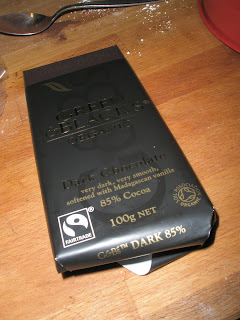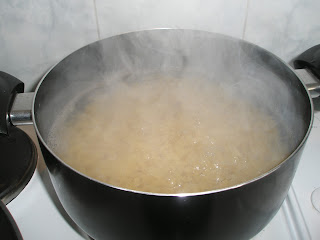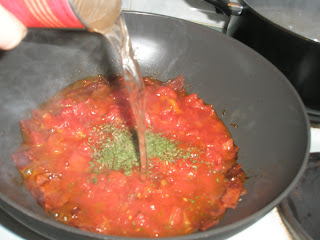Nigella then goes on to announce that she is going to make a chocolate peanut-butter cheesecake. Booyeah! I exclaim. Chocolate and peanut butter are like the Cheech and Chong of vegan dessert. calming myself, and taking my pen in hand to take notes I admonish my television.
"Nigella this had better be good, I can't get in the fail-zone here"
The recipe starts off with a biscuit base for the cheesecake. Nigella wants you to use the following.
200g biscuits. I used "Nice" biscuits, because a packet of Arnott's Nice biscuits are vegan (seriously read the label... no milk, no butter, all vegetable shortening, flour and sugar) and well, they're... pretty good! (sorry I did steal that joke from a friend.)
50g butter. I replaced this with 50g of Nuttelex, and 1 tablespoon of vegetable oil.
Sorry, for those who are a bit new to cooking here's a quick spoon tutorial.
 | |
| There are three spoons. |
The spoon in the middle is a dessert spoon. It's the type of spoon you see at restaurants used for eating desserts. This isn't usually used as a measure in recipes, so if I ever use one I'll use its full name so there's no confusion.
The spoon on the right is a table-spoon. You may also know it as a soup-spoon. It should be the biggest spoon in the cutlery drawer. A standard tablespoon should hold 25ml of fluid. In recipes it will be referred to as a "tbsp"
Moving on. I have 200g biscuits, 50g Nuttelex, and a "Tbsp" of vegetable oil in a big mixing bowl.
Nigella wants me to throw in 100g of chocolate chips.
I decided to make this recipe a bit more "grown up" by using very strong dark chocolate. My chocolate is 85% cocoa mass, here it is.
 |
| mmmmm chocolate. |
Instead of Nigella's 100g of chocolate chips I've used only 50g of this chocolate. It's much stronger in flavour. I use just a regular knife, and chop it into small but roughly-shaped pieces. Leave it on the bench for now, or put it aside.
Nigella also wants me to use 50g of peanuts. I decide to balance out the quantities here, and add in 100g of salted peanuts. Ie Nigella's Peanuts + chocolate = 150g, and so does mine. I've just changed the ratio around.
Nigella just throws all of these ingredients into a food processor and wizzes the living daylights out of it. I don't own a food processor. They're a bit expensive to buy and they use lots of electricity. They also take up a fair bit of bench real-estate, so if you only use it occasionally or have a small kitchen, it might not be the gadget for you.
I do need to crush my biscuits down to crumbs though, so here's my solution.
 | ||
| Maguiver... kitchen edition. |
Once you have your biscuits crushed down to crumbs. (took me about 5 minutes of work) then mix through your chocolate chips and peanuts. then add the oil and the butter. I used my fingers to work the butter through the biscuit mix, being careful to use just the tips of my fingers up to the knuckles, and squashing the butter and biscuit mix between my fingers and thumb until the contents of the bowl is completely mixed through. (homogeneous in engineering speak)
Once you've done that, you need to transfer your biscuit mix to a "spring-form tin" this is a fancy cake tin that has a spring-loaded release so you can take the sides away from the cake at the end of the job. It's okay if you don't have one. You could assemble this in a shallow pie tin, or a square casserole dish, the only catch is that you will need to be careful with a spatula to get portions out at the end, and accept a bit of mess on the way out. If you want to find yourself a spring-form tin, they are at most shops that sell kitchen-type stuff, or keep an eye out at 2nd hand sales, as I find often that the older style baking tins and kitchen gadgets feel a bit more robust than the chain-store stuff. That being said, if you're only going to use your spring-form tin on special occasions, then don't feel like you need to spend a whole day's pay on the thing. Just get the cheapest one you can find, or drop me an email and borrow mine.
Enough waffling. Here's what my biscuit base looked like.
 |
| Cheesecake foundations. |
Put this in the fridge, and when you're ready get to work on the rest of the cheesecake. We're going to make the filling now.
Firstly, pre-heat your oven to 170C.
Obviously... vegans don't eat cheese. The bulk of my cheesecake filling is going to be made from a really awesome product called Tofutti. It's a tofu-based "better than cream cheese" that really tastes excellent. You find it in the fridge section of the supermarket, next to the regular cream cheese. A word of caution, for some reason it's a bit hit and miss with finding this stuff at the shops... sometimes woolies will have it, sometimes they're out of stock, sometimes they just don't carry it at all locations. Coles doesn't carry it at all. I think that you can order it through woolies online though, and get it delivered anywhere in their delivery network.
Here's the tofutti.
 |
| Tofutti |
None of the carbon from the filter ends up in the final product, but it's used to make the white sugar that may go into the Tofutti. As a vegan I'm sad that the use of animals gets into so many industries and areas of our lives, into things that we wouldn't even think of. However, I still use Tofutti for 2 reasons. Firstly, the main competitor to Tofutti (Kingsland) cream cheese uses commercially obtained "raw" sugar. I'm sure you've seen the raw sugar at the supermarket, the crystals are a bit bigger, and not as white as the finer white sugar. Raw sugar is just white sugar that's had some of the cane juice mixed back in to give it a more "natural" feel in a lot of cases. So not only is it filtered through the same bone-char filter that the white sugar is filtered through, but it's had some of the waste product, containing traces of that bone char mixed back in with it, it doesn't taste as good and you need to go to the health-food shop to buy it... if you're lucky enough to find one who stocks it.
In a world with less demand for animal products, the skeletons of cows, pigs and sheep wouldn't be considered a waste-product to be burned down and sold to food and chemical processing plants, we'd find another solution to filter our sugar cane. The act of buying Tofutti doesn't provide material support to the animal exploitation industry, and by asking for it at your local supermarket you're creating a vocal demand for animal-free products. I personally think arguing about Tofutti when there's battery hens and veal crates is kind of missing the forest for the trees. Not every vegan will agree with me on this one, that's okay this world would be a boring place if everyone saw eye to eye on everything.
Okay, moving forwards. I'm going to use both of those containers of Tofutti in this recipe. So, into the mixing bowl they go.
Now, it gets complicated. Nigella has very helpfully told me to use "a dollop" of sour cream, and "a splodge" of peanut butter. She also wants 3 eggs, and 3 egg yolks. Ha! you have to own up to exactly how many eggs you used!
I mutter at the TV "stop stuffing me around Nigella, just give me your recipe!" I make an executive decision.
I'm going to use some silken tofu to help bind it together, that will do the duty of the eggs, and part of the duty of the sour cream.
Silken Tofu looks like this
 |
| Fermented soy goodness. |
Place the block of silken tofu on your chopping board, and take the portion you need. This is a 300g package, and I used half of the packet, so 150g of tofu.
To keep your left over tofu fresh, keep it in a container covered in water in the fridge. I just re-used my tofu container like this.
I translated Nigella's "splodge" of peanut butter into a very generous 150grams.
Now into that mixing bowl with the tofutti, tofu and peanut butter you need to add 200g of sugar. Yes, I've used white castor sugar.
As an added extra, I'm putting in 1tbs (yes you cooking champion you know that's a tablespoon) of lemon juice. This is to replicate a little bit of the sourness of sour cream. Again, at this point, Nigella presses a button on her food-processor and looks winsomely at the camera for a moment as the electric motor whirs into action and makes her cheesecake middle homogeneous. I use a wooden spoon. Free workout, saves electricity. Take the time to mix it gently, to make sure the tofu is fully incorporated. It should look smooth and glossy.
 |
| Almost perfectly mixed. |
Once you are happy with the taste, it's time to get your biscuit base out of the fridge. Pour the cheese-cake mix over the biscuit base, and use your wooden spoon to very gently spread the cheese-cake middle around making sure the biscuit base is fully covered. Scrape the bowl really well, you want to get it all onto the biscuit base.
Nigella didn't give an accurate baking time in her show.... The paranoid part of me is starting to think that she just wants you to watch her cook... she doesn't want you t o cook it yourself from the DVD... maybe it's a shameless ploy by "the man" to make you rush out and buy the book. Don't be co-opted into the TV chef mantra of "it must be perfect."... I just take a punt, and set my oven timer to 20 minutes. You could quite safely eat everything in that spring-form tin as-is, there's nothing that needs to be cooked to prevent food poisioning. At the same time, I want it to bake a little bit to let the Tofu help set everything together, and for those chocolate chips in my biscuit base to melt and mush around a bit.
I check on it at 10 minutes, but decide to let it go for the full 20 minutes. Your oven may be a little bit more keen than mine, so I'd suggest a 10 minute check-up on your cheesecake is a good idea. By the time it's done, the top will have gone a slightly darker golden brown and the biscuit base will smell just wonderful. Warm, sweet, chocolatey and inviting.
Once it's baked set your cheesecake aside to cool.
You're going to prepare the rich chocolate ganache topping. I've used very dark chocolate to make mine a bit grown up. I love the bitter dark chocolate taste. If that's not your preference, then check out the health-food aisle of the supermarket or the "allergy aisle" and get yourself some dairy free chocolate. It's milder and a bit smoother than the rich dark chocolate.
I took 150g of my chocolate, and placed it in a double boiler. Goodness, what's a double boiler you say. Well, again it's something you can buy to put on the stove to help you melt chocolate, or you could just make one like I did.
 | |
| Maguiver... kitchen edition. |
To my chocolate I added 50g of nuttelex and half a cup of icing sugar. I mixed it over the hot water until everything was fully combined. Your mixture should look glossy and beautiful.
Then, while the mixture is still quite warm spread it over the top of the cheesecake. you need to be very gentle here, as the "skin" on the top of the cheesecake layer is fairly fragile, so it's easier if you pour from the bowl across the area of the cheesecake to minimise the amount of spreading you need to do. I used the back of my dessert spoon to gently spread it around.
I then sprinkled the top of the cheesecake with a handful of peanuts. This is kind of in homage to Nigella. She finished this episode by slinking to her fridge, a svelte sexy figure clothed in silk, sneaking through the night to steal some leftovers... she sprinkles her chocolate covered cheesecake with a hand-full of salty peanuts and devours a deliciously large mouthful.
So, I sprinkle my whole cheesecake with salty peanuts to offset the bitter-sweet rich chocolate topping. I live by myself (with the cats) so slinking to the fridge is a bit redundant, I'm just saving myself from an injury induced by tripping over a cat while trying to out-slink a natural hunter to the fridge in the dark.
You're almost finished! place your cheesecake in the fridge, and let it set for a few hours. Overnight would be even better.
I took my cheesecake into my office today, to share as part of a harmony day morning tea. I decided that since we'd all been invited to share food that was important to our personal culture or heritage, that I'd like to share my vegan food culture with my colleagues. It takes a rather brave soul to try a new recipe with a pretty major degree of ad-libbing upon work colleagues, but that's just how I roll I guess. I'll admit to a small amount of trepidation when I un-hinged the spring-form tin in our little office kitchen.
Here's how it went.
 | |
| Yayyyyy111!!!111 |
"I've only ever had tofu in stir-fries before I didn't know you could do this... I'm a fan"
"Lovely, really light, fluffy, sweet..."
"If you hadn't have told me that there was no dairy in this I would have thought it was made with real cream cheese"
and my review... is in the title of this blog entry. The best vegan cheesecake I have ever made. Rich, indulgent, sweet, powerful. This was something I was very proud to present to my colleagues, all of whom are people I like far too much to want to see them eating mediocre food.
So the verdict.
This dish is a lot of work... but a cheesecake in general is a lot of work, so I wouldn't rate it as being more work than making a cheesecake with actual cheese and eggs in there. It's a bit of a step up if you're a novice cook, but it's do-able. Just take it slowly, and don't do it in a rush, you'll be fine.
Cost... my version is possibly more expensive than Nigella's version. The Tofutti isn't cheap, about four bucks a container. The fair-trade dark chocolate is also not cheap. You wouldn't be making this every week, as far as an indulgent dessert goes I think it really delivers great bang-for-buck.
Appearance... I liked it, and my colleagues generally enjoyed the appearance of my cheesecake. The edges are a bit crumbly in the picture, but remember mine has taken a trip from home to the office.
Enjoyment.. I enjoyed making this, I enjoyed eating it. (I have a bit of a sugar high now actually) and I really, really enjoyed watching a bunch of non-vegans turn take the first bite with a bit of trepidation, then rapidly savour their way through the rest of the serving.
Nutrition: My version will have less saturated fat than Nigella's, and probably less total fat, and a lower calorie count. Nigella's will contain some vitamin B12 from the egg yolks, which my version won't have. My version with the darker chocolate will have more polyphenols and isoflavanoids.... and nobody wants to be polyphenol or isoflavanoid deficient. I don't think you eat this dish for nutrition, but if you have heart issues, or really need to cut out the cholesterol and saturated fat, then the vegan cheesecake is a great way to literally have your cake and eat it too. Making it vegan makes it cholesterol free.
Yay Nigella thanks for getting me out of the fail-zone here!
If you have a quiet afternoon and want something truly indulgent to share with someone you like, then you should really make my dark chocolate and peanut butter cheesecake.

















